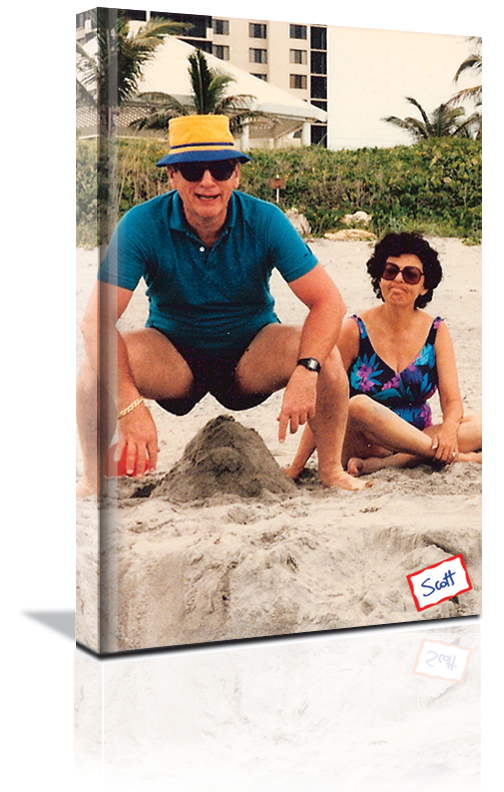 Twenty years ago, my dad jumped.
Twenty years ago, my dad jumped.
He broke ties with his corporate owners and went out on his own.
And for the first year, he was working from home, struggling to build inventory and scrambling to find customers. Not exactly our family’s finest hour.
But, he still cites that move as his best decision ever. And two decades later, his company still remains the best in the business.
Now, of all the memories related to that transition, here’s the one forever etched upon my heart:
I was twelve years old, and my dad brought me to work to see his new warehouse. It was the single biggest thing I’d ever seen. Something like three hundred thousand square feet.
But the building was empty. The place was a ghost town. And there was no merchandise.
Except for one palette.
One lonesome skid of inventory in the entire warehouse, shrink-wrapped to perfection –with a big white sign on it that read, “Sold.”
Try to picture yourself standing it that warehouse.If that’s not risk, I don’t know what is.
If that’s not faith, I don’t know what is.
AND THAT’S THE POINT: When you jump, when you stop dragging your feet and dive into what matters, you have to trust yourself, your resources, your abilities, the process, the people – along with the universe that contains them all.
Otherwise you’ll find a millions reasons not to take action. You rationalize your way out of risk. Like the people who make lists of all the reasons to avoid committing with both feet.
Sure. That’s the perfect way to procrastinate my way to mediocrity. Well done.
On the other hand, you could jump. You could start taking massive, relevant action – today – to minimize or eliminate barriers to your boldness.
Here’s a collection ideas to help you stop dragging your feet and dive into what matters:
1. Accept that you’ll never be ready. Admit it: The reason you’re still dragging your feet is because you’ve still convinced that having a plan is necessary.
It’s not. Failure isn’t the product of poor planning – it’s the product of timidity to proceed. You can’t allow yourself to be stopped by not knowing how.
Try this: Lower the threat level of your jump by pulling a partial. Ask yourself: What is an easy, inconsequential version of this scary action I could take right now?
Challenge yourself to execute three of those a day. Repeat that enough, and you’ll either get the whole thing done incrementally, or sustain enough small victories to pull the trigger when the time is right. Not perfect, but right.
Look: I know you’re scared. I also know that constant, determined action cures fear, builds confidence, develops courage, generates inspiration and vaporizes stress. What other risky (but reasonabl) jumps can you make today to move forward?
2. Deliberately alter your course. Nashville rocks. Literally. Affectionately known as “The Music City,” it’s packed with millions of passionate songwriters who, at one point, stopped dragging their feet and jumped.
My favorite part of the town is the energy. It’s as electric as the guitars. And I’ll never forget my first trip there. My client took me out on the town after my workshop.
When we walked into one of the hundred honky-tonk bars on the strip. And I noticed a bumper sticker on the bathroom stall that read: “Screw it. I’m moving to Nashville!”
There’s no better way to personify the risk of jumping than those six words. Because if you put yourself in the shoes (er, boots) of somebody who once said that to himself, you understand what this is all about:
Accumulating enough frustration, passion and fire that you simply can’t take it anymore. That moment when you notice a deficit in yourself because every waking minute of your life is an insult to the gifts you’ve been granted.
That’s when you jump. Even if you’ve screwed up everything so far. You jump anyway. And if you haven’t reached that point yet, don’t worry: You will. You’ll know what to do when you get there. It might not be moving to Nashville, but it will involve altering your course. Will you allow today’s possibilities to be shaded the failures of yesterday?
3. The world is your mentor. There’s a phenomenally simple book by Mike Hernacki called, The Ultimate Secret to Getting Absolutely Everything You Want. It can be summarized in one sentence: You have to be willing to do whatever it takes.
Whatever. It. Takes.
The challenge, it will be different for everybody, depending on what you’re diving into. My suggestion: Find twenty people who have jumped off the same cliff you have. Email them. Briefly introduce yourself. Tell them you’re a fan of their work. Tell them you’ve decided to jump. And tell them you’re willing to do whatever it takes to become the walking execution of your vision.
Then, ask them if they’d be willing to offer themselves – in any capacity – as a resource for your success. Not everyone will respond. But the ones who do – the ones who see something in you that someone once saw in them – will be happy to oblige. How many mentors do you have?
4. Grow a thicker skin towards the naysayers. Believe it not, not everybody wants you to become successful. In fact, much of the world will do everything they can to prevent you from diving into what matters.
Maybe because they’re jealous. Maybe because they’re scared they’ll lose you. Or maybe because they know your success will expose their averageness. Either way, you have to accept this reality. You have to be okay with the fact that not everyone you encounter wants you to jump.
But, your ability to withstand criticism without crumbling is a leading determinant of your success. And at the same time, don’t ignore the naysayers. It depends on the source, the validity of the comment and the context in which the criticism was offered.
My motto is: Criticism keeps you in check when it’s right, and keeps you in chuckles when it’s ridiculous. And as you prepare to jump, just remember: You’re nobody until somebody hates you. Besides, if everybody loves what you’re doing, you’re probably doing something wrong. Is your skin as thick as a reptile or as thin rice paper?
5. You’re never unpartnered. Although not everybody wants you to succeed, success never comes unassisted. That’s the cool thing about commitment: Once you stop dragging your feet and dive into what matters, the world begins to yes to you.
That’s what happens when you put yourself in the way of success and advance in the direction of your dreams: Eventually they will have no choice but to come true. Providence will move to orchestrate the ideal conditions for you to win.
As Paula Coelho wrote in The Alchemist, “If you follow your dream – your personal legend – all the world will conspire to help you.” When this happens, it’s almost spooky.
In fact, I remember spotting this trend when I first jumped. Help came out of nowhere. Opportunities presented themselves to me. And I was smart enough to leverage every opening the universe gave me.
But the door must be opened from the inside.
And you have to be fueled from the heart – not for the wallet. Otherwise your misguided intention will fill the room like a garlic fart. Ultimately, if you want the world to say yes to you, you’ve got to sing the song that is natural for you to sing, in the way that is natural for you to sing it, and it in front of the audience that needs to hear it the most. Are you paying homage to the voices that shaped you?
6. Conserve your oxygen. Don’t waste your breath on useless chatter. Next time you find yourself surrounded by people consumed with small thoughts, walk away. Set that boundary. Otherwise their mental shallowness will infiltrate your world.
My suggestion is to work exclusively in environments that allow you to escape the crutch of small-mindedness and think more importantly.
That means hanging with people who ask big, dangerous questions that catapult your thinking. That means talking about big, relevant issues that challenge your thinking. That means learning about big, new concepts that stretch your imagination.
The hard part is keeping yourself accountable. Try this: Be unwaveringly vigilant about the company you keep by asking the question, “Does this person add gasoline to or sprinkle water on my internal fire?”
Also, be persistently discerning about the media your consume and the ideas you focus on by asking, “Will I definitely use this information for something immediate and important?” In the end, life’s too short for television. Life’s too short to surround yourself with people who don’t challenge and inspire you. And life it’s too short not to do something that matters, as Hugh McLeod says. What do you need to delete from your life?
7. Do this and nothing else. Enough dabbling. Either go full time or go home. Go pro or go away. Be dedicated or be eliminated. That’s what it takes to win. You have to throw yourself wholeheartedly into the game.
Sadly, the number one reason people can’t dive into what matters is because they insist on keeping one leg firmly planted in what doesn’t matter. Bad move.
I’ve made it myself. When I first started my publishing company, I had a full-time job selling furniture. Writing books and giving speeches was just something I did at nights and on the weekends.
But after a year, I scaled back to part time. And I started parking cars a few shifts a week to make ends meet. Which worked for about a year. But the problem was, sometimes I’d work eighteen hours a day. And while my business slowly grew, so did my ulcer.
It was simply too much. And that’s when I finally jumped. That’s when I said, “Alright. This is it. I’m going to do this, and nothing else. Let’s go.” And I never looked back.
That’s the cool part about focus: It’s the first step toward freedom. It’s the fuel that drives the engine of wow. And it’s the solitary suggestor of success. It’s time to take your index finger, cover up the tip of the hose, and shoot out a frozen rope of concentrated effort.
Otherwise you’ll never shed your amateur status. How much time are you spending on things that diffuse your focus and hamper your goals?
Okay. Enough dabbling. Amateur hour is over.
It’s time to jump.
It’s time to put an end to half-measure living.
It’s time to stop dragging your feet and dive into what maters.
I know you’re terrified.
But sliding down the side of the mountain on your ass isn’t going to bring you closer to your dream.
If you’re going to jump – jump with all of your might.
Because there’s no going back to the top of the cliff.
LET ME ASK YA THIS…
Are you prepared to turn your desire into your obsession?
LET ME SUGGEST THIS…
For the list called, “65 Things I Wish Somebody Would Have Told Me When I Started My Company,” send an email to me, and you win the list for free!
* * * *
Scott Ginsberg
That Guy with the Nametag
Author, Speaker, Entrepreneur, Mentor
[email protected]
 Never the same speech twice.
Never the same speech twice.
Now booking for 2011!
Watch The Nametag Guy in action here!


 It’s hard to love people who betray you.
It’s hard to love people who betray you.
 Relationships work when you work at them.
Relationships work when you work at them. After wearing a nametag twenty-four seven for a decade, my badge became a brand.
After wearing a nametag twenty-four seven for a decade, my badge became a brand.  Commitment changes everything.
Commitment changes everything. Life is not a Nike commercial.
Life is not a Nike commercial. Rarity is inherent.
Rarity is inherent.  Everyone needs a good cheerleader.
Everyone needs a good cheerleader. Intensity is highly overrated.
Intensity is highly overrated. Twenty years ago, my dad jumped.
Twenty years ago, my dad jumped.